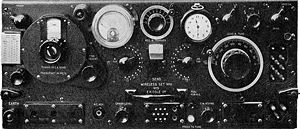Wireless Set No. 11
| Wireless Set No. 11 | |
|---|---|
 | |
| Production history | |
| Introduced | 1938 |
| Specifications | |
| Weight | 43 lbs |
| Length | 19.5" |
| Width | 12" |
| Height | 8.5" |
| | |
| Frequency range |
4.2–7.5 MHz |
| Power output |
4.5 watts max |
| Range | up to 20 miles |
The set has a sender receiver on the left, a low power supply unit to its right and a high power supply unit beside that; however the set could be operated with just the low power unit. The set and supply units fit into an aluminum frame that can be adjusted for either configuration. The frame, if in a vehicle, was mounted with rubber shock mounts similar to 19 set ones. When used on the ground, the set came with a clip on face cover, often stenciled with "WIRELESS SET No.11" which, when removed, had two fold out legs and the cover became a table to put the set on and keep it out of the mud. Like many lids and covers, this one too had a metal plate with working instructions attached on the inside.
Connection between the units was with cables that plugged into sockets on the face of the components. A replaceable ammeter on the sender/receiver was protected by a quick release clear plastic cover. Aerial connections from the set went through a Condenser No.5 on the top of the sender receiver to either an aerial base or a Aerial Coupling Equipment C which allowed the aerial to be remote from the set. A remote Wireless Remote Control Unit A could link the set to other sets, field phones or a switchboard. Like most early British radios, changing between ‘send’ and ‘receive’ was accomplished by operating a large switch on the set (the big white one) rather than a pressel switch on the microphone.[2]
Size was 8-1/2" tall, by 12" deep by 19-1/2" for the set and each of the LP and HP units added another 4-1/2" each to the width. Weight for the complete station was 216 lbs. (or 180 lbs. with just the Low Power unit), Frequency coverage was 4.2 to 7.5 MHz, range from 3 miles R/T voice on low power up to 20 miles CW (Morse) on high power. Power supply was most commonly 6 volt lead acid batteries, however 240 volt dry batteries or a rotary converter could also be used.
The Canadian sets made by Canadian Marconi Company differs from its British cousin by having a green wrinkle finish instead of black.
Related Pages
- Erection of a Wireless Set No. 11 Ground Station WW2 Video
- Signal Training Volume III, Pamphlet No. 19, Wireless Set No. 11, 1939
Related Items
References
- ↑ Wireless for the Warrior
- ↑ Information provided by Bruce Parker








